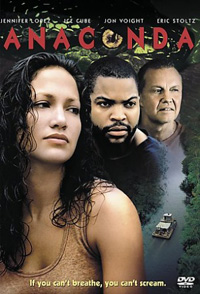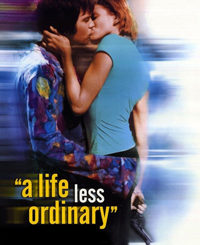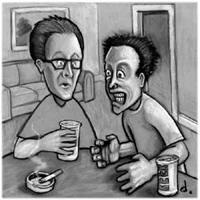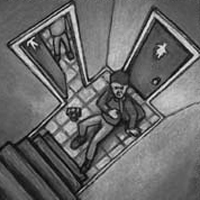 Anaconda
Anaconda
With Jon Voight, Jennifer Lopez, Ice Cube, Eric Stoltz
Written by Hans Bauer and Jim Cash and Jack Epps, Jr.
Directed by Luis Llosa
by Adam Haynes
Anaconda is about a bunch of people who travel on a riverboat deep into the heart of the Amazon on some sort of social science mission and get completely fucked up by large snakes. Eric Stoltz plays an anthropologist who swallows a bug and goes into a coma… Ice Cube plays a cameraman and looks much cooler than anyone else, particularly when he puts on a Crips headband and kicks reptile ass… Jennifer Lopez, as a documentary film director, wears a sweaty tank-top which seems to get smaller and tighter the more anxious she gets… Jon Voight (who I could have sworn died two years ago) is rescued from a shipwreck and looks just like the Creature from the Black Lagoon, except with a pink t-shirt and Joni Mitchell hair. He used to be a Peruvian priest, and now makes crazy faces and drools while explaining the law of the jungle… And hey, guess what – not only are anacondas very big and rare, they are not vegetarians… My Lord, could it be? Yes, an honest to goodness monster movie!
Do you remember monster movies? I sure as shit do. They were what I watched as a kid on channel 56 every Saturday afternoon. Who could resist the… creatures on the screen, gloriously done up in foam rubber and discount spray paint, with storylines so formulaic that when the characters were introduced at the beginning of the movie I would point my finger at the screen and say aloud with authority, “You, sir, are the hero’s best friend and you’re fatter than shit – therefore you will be the first to die in the jaws of the giant humanoid rat!” There was always something very powerful and relevant about these movies and now, somewhat wiser as to the ways of the world, I know what that something is.
Sex, of course.
Monster movies are the industrial answer to the agrarian fairy tale – both are fundamentally concerned with sexuality and its relationship to the human spirit. And not the pure and simple interpretation of sex, done up all pretty on the Playboy Channel. We all know that in reality there is nothing pure or simple about sex, and this is precisely what most of these movies are about.
Anaconda is a perfect example. It doesn’t take much of an intellectual stretch to realize this movie is really about the masculine id – sexual energy on a total freak out. The Amazon setting isn’t a jungle so much as a retreat from the normal confines of the psyche, and these aren’t really huge snakes you see before you – they’re huge penises! I’m not kidding – read Freud. Is it a coincidence that the huge penises come rushing out of the dark water (a classic metaphor for the unconscious) only after certain members of the cast start getting it on (thus awakening the idish forces)? I don’t think so. Is it a coincidence that Cube and Lopez, in an effort to finally destroy the last huge penis, trap it in a huge smoke stack (which further symbolizes great phallic power) and then blow the fucker up? Again, I think not. Finally, when Cube is beating the large, mostly blown up penis back into the murky water with an ax, does he tell the penis that it is a “bitch,” simply because he is employing inner city vernacular – or is he really verbally reestablishing the dialectical balance between masculine and feminine energy to help drive the penis back into the safety of the greater unconsciousness? In a place slightly south of our hearts I think we know where the truth doth lie.
Another thing about good monster movies is that they should never be very well made. Take away the goofy, campy luster, and they no longer “work” as self-sufficient pieces of art. Bad acting, marginal plots, and third grade special effects are essential in liberating the libidinous material from the normal, more conformist confines of cinematic storytelling. Seen in this light, the fact that the archetypal giant humanoid rats are obviously shag rugs glued onto golden retrievers isn’t just amusing, but completely central. Since the genre focuses on the exciting out-of-control nature of sexuality, the sloppy execution enhances this theme even further – the medium is the message and all that jazz…
Interestingly, more recent efforts have shown us that consciously employing the abovementioned strategy does not always a good monster movie make. It is clear now that producing monster movie art becomes a sort of Taoist exercise: you shouldn’t think too much about what you’re creating or you’ll have created something else (or for you Western geeks: since these movies are largely championing the unconscious in all its glory, it takes more than a certain amount of unconsciousness on the part of the filmmakers to uphold the formula’s integrity). If you tell the story with intentional campy smugness you end up with stale comedies like Tremorsor Innocent Blood. Too slick and realized will give you the mechanical banality of Jurassic Parkor Wolf.
But just when it seems like there is no hope for the genre, Anaconda comes along, proving the magic is still there as long as you follow these careful guidelines. One: take a mediocre script and rewrite the sucker to the point of utter incomprehensibility. Two: hire Luis Llosa because you’ve seen both Sniper and The Specialist and you know this is a man who is at no risk of muddying the material with anything remotely resembling artistic pretensions. Three: hire an ensemble of actors who are far more gifted than the dialogue given to them, but not gifted enough to elevate it in any way (the only actor who rises above the material is Stoltz who thankfully goes into his coma by the end of the second reel). Finally, add computer animation that looks like it came from a three year old car commercial. Now that’s a recipe for true monster movie magic! Anaconda, with as much skill and grace as a cerebral palsied breakdancer strung out on speedballs, manages to be bland, exciting, stupid, gross and dirty all at the same time… effortlessly. A more splendid sticky triumph has yet to be seen this year.



